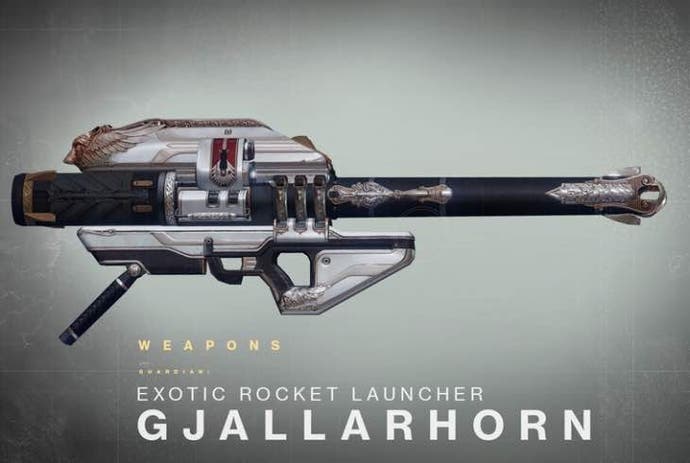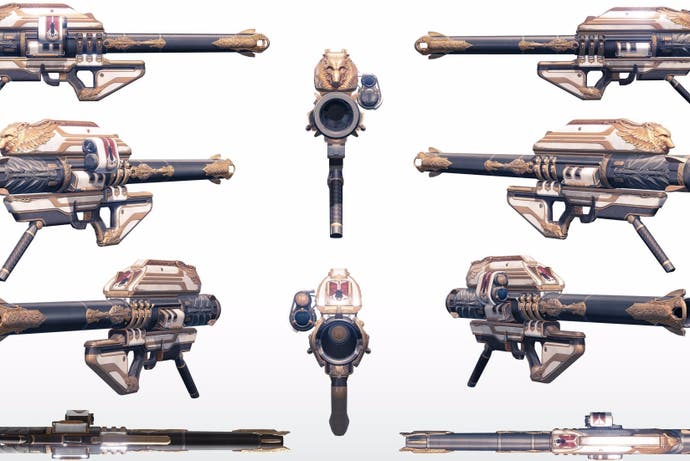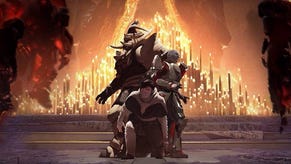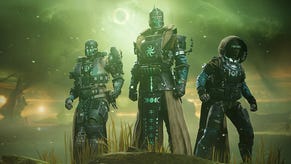Requiem for a rocket launcher
Looking back at Destiny year one's biggest prize.
Before it was a rocket launcher with target tracking and devastating cluster rounds, Gjallarhorn - from the Old Norse "yelling horn" - was the instrument sounded by the herald god, Heimdall, to signal Ragnorok. The noise of Gjallarhorn, in other words, meant the end of the world - which, in a way, is just as true of its deadly, wolf-headed descendant in Destiny, a gun which proved so powerful it called down an armageddon on itself.
It's hard to remember exactly when Gjallarhorn became the essential destructive accessory in Bungie's RPG-ing online shooter. As players hit the level cap and explored the endgame and metagame beyond, exotic weapons were earned and upgraded, perks were tried and tiered, and certain guns and gear - outliers and exceptions within Destiny's carefully balanced economy of violence - became highly prized.
Gjallarhorn was the top prize. A combination of functionality perks and brute-force damage-dealing made it a monster. A fully-levelled Gjallarhorn fired rockets that homed in on their targets, then exploded on impact and released a devastating secondary wave of Wolfpack rounds that also homed. It was beautiful to watch, and always made me think of the Japanese word for fireworks - hana-bi, literally "fire flower" - with its twinkling incendiary packets pluming away before arcing murderously back onto their victim. It also held two rounds in the clip and, as a consequence, delivered precise and overwhelming damage to anything players decided to point it at in a very condensed pocket of time. It was bullying, and extravagant. And it was so good.

So good that it became a testament to everything wonderful and infuriating about Destiny, a symbol of the compulsion and power of Bungie's game. Gjallarhorn was a reward ripped from the raw and manipulative system of numbers and grind that filled the awkward silence left when the game's story stopped mid-sentence. As the the most sought-after exotic, it became the ultimate symbol of Destiny's controversial pull, of the repetitive hunt for light and loot that gave the game its mechanical long-term appeal.
With players - even committed ones - feeling somehow locked into a combat of fortune with a game they couldn't stop playing, finding Gjallarhorn didn't just feel sweet, it felt like a form of cosmic retribution. The gun was almost game-breakingly powerful. It felt like a thing you should not have, a contraband toy capable of blowing a hole in the side of Bungie's rigidly regulated universe of drop rates and damage totals. In a system of tethering statistics Gjallarhorn felt like a glorious release, and it made running the game's hardest missions simple. Atheon, the boss waiting at the end of Destiny's first raid, could be reduced to rubble after a single portal run to lower his defences. Downing Crota to make him vulnerable to sword attacks at the end of the game's second raid was simple aim-and-fire. And the complex, crushingly tough battle with Skolas capping the Prison Of Elders level 35 run could be cut to a 40-second mugging.
This power was - as power always is - ultimately divisive. It created a class system within Destiny - on the one hand, the fortunate few with God in their pocket. On the other, the perpetual losers of Destiny's uncaring loot tombola. Players who ran three characters through both raids on hard every week for months and came up empty. Players denied access to unofficially matchmade fireteams which considered Gjallarhorn a condition of entry. Players who were the necessary dispossessed in the brutal behavioural capitalism of Destiny's RNG - an RNG that could feel, for truly invested players who just wanted to join in the fun, as ruthless and unforgiving as a mafia extortionist. 21 Crota kills and no Gjallarhorn? Screw you, play me. Bought 10 engrams from Xur and come up blank? Screw you, play me. 400 hours down and nothing to show? Screw you, play me.
And of course it became too much. They killed it, and they killed it on purpose. The recent update 2.0, a hefty overhaul tidying up the Destiny universe ahead of the arrival of The Taken King expansion, rendered Gjallarhorn unexceptional along with some other exotics - the towering sniper rifle Ice Breaker, a whole line of jolting hand cannons - which had narrowed the pathways of potential playing strategies, and too successfully turned the best way into the only way.
Before that, though, Bungie did something to acknowledge the extraordinary influence and status of Gjallarhorn, the weapon that was too powerful to live - they put it on sale. Xur, the shadowy merchant who arrives once a week to sell an ever-changing stash of rare goods, democratised Gjallarhorn by making it available to anyone with enough strange coins (or anyone who could muster enough by the time he slipped away - there was a flurry of Nightfall runs and Public Event hunting as players frantically filled up their Strange piggybanks).
It was like turning all the arcade machines to free play ten minutes before closing - letting everyone have a go of the sparkling light show we'd been watching for so long. This is when I finally got Gjallarhorn, and a chance to stand at the other end of those tracking rounds. It was, I thought, more or less how people had described it - a guilt-free easy mode, a panacea for the bullet-sponge complexity of Destiny's most arduous fights, and above all a spectacle, of power and pretty explosions.
The cruel thing is perhaps that Bungie isn't simply getting rid of Gjallarhorn and the other exotics, it's just not updating them. They're not really being killed, just abandoned - while selected other weapons can be upgraded to year two standard and still prove essential to high-level play, Gjallarhorn will be stuck dealing half the damage of the elite weapons, diminished and impotent.
Gjallarhorn is gone, in other words, in the name of balance, as update 2.0 makes sweeping changes to all the weapons and armour systems in Destiny. But with a system this complex, a system that also features regular additions to keep players playing and interested, the pattern that saw Gjallarhorn's rise will almost certainly reassert itself: discovery, exploitation, a hungry grind and, finally, the party-ending nerf. Which is to say that Gjallarhorn is gone, but something will take it's place. We just need to find it.

















